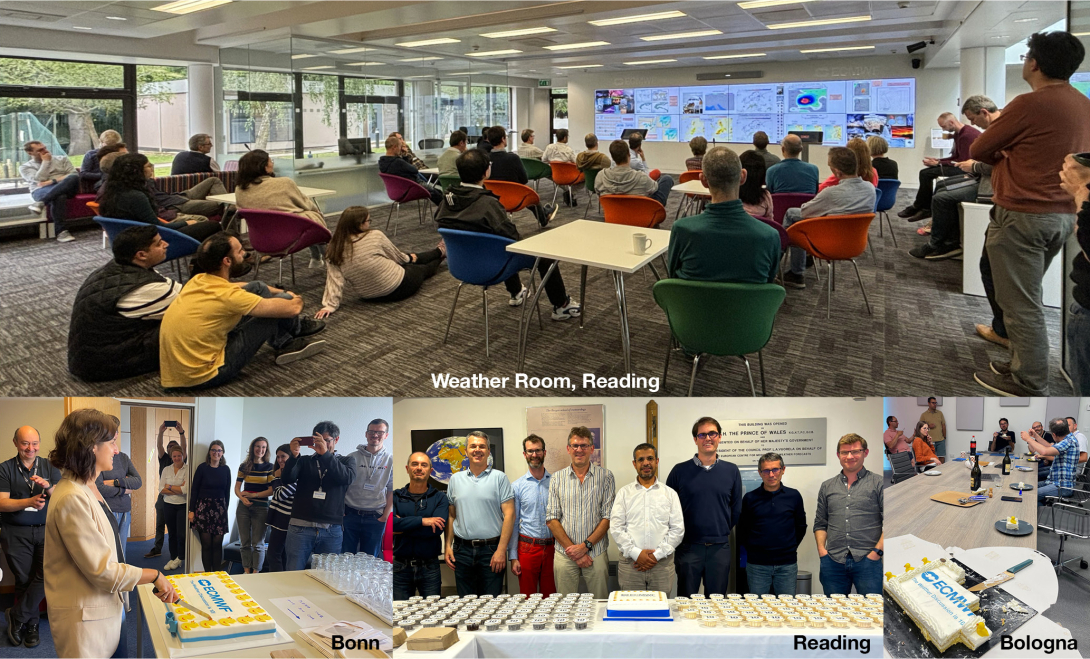The very first ‘Weather Discussion’ was delivered about ten years ago, on 20 June 2014, by Linus Magnusson at ECMWF’s Reading (UK) site. Ever since, this has been a very popular and productive Friday afternoon event in the internal ECMWF calendar. Accordingly, on 14 June 2024, ECMWF marked age ten with multi-site celebrations in Reading, Bonn (Germany) and Bologna (Italy).

How is this relevant to readers? The key point is that the Weather Discussion focuses specifically, in a real-time-weather framework, on improving forecasts for the benefit of all users, and indeed issues discussed are often those raised directly by users. Discussions often evolve into entries in the severe event catalogue (https://confluence.ecmwf.int/display/FCST/Severe+Event+Catalogue) and/or Newsletter articles. Below we describe this activity in a historical context.
Origins
The inaugural Weather Discussion in 2014 linked to an ECMWF project instigated about two years earlier, under the leadership of the then Director-General Alan Thorpe. This project involved converting the old ECMWF library into a bright new open space to be called the ‘Weather Room’. It was to be a multi-function space, used for informal meetings, journal browsing, and breaks and poster displays during workshops. Staff and visitors alike could also check out and discuss some of the latest forecast information on a large, interactive, multi-screen ‘weather wall’ (front of room on the picture). Within the space, there is also a glass-walled ‘pod’ (towards the left on the picture) equipped with desk and workstation, where, for a week at a time, the rostered on-duty ‘Daily Report analyst’ is typically based. This enables easy interactions with other staff and visitors on current meteorological topics of interest, such as real-time forecast and analysis issues. Each week culminates with the analyst leading the Weather Discussion on the weather wall.
Previously, ECMWF had had rostered analysts, but they were based in a remote corner of ECMWF, surrounded by a plethora of paper charts that had to be renewed daily. And whilst they did write a report every weekday, in-person interactions were disappointingly rare, and there were no Weather Discussions.
Since its inception, the Weather Discussion has been a meeting point – physical, then virtual, and nowadays hybrid – at which current meteorological topics of interest can be presented and then discussed with the audience. The goal is to improve ECMWF forecast performance, in many different ways, by working collaboratively. The initiative has been an unequivocal success, and the event has remained very popular, typically attracting about 100 attendees.
Issues
Many issues have been identified, and many corrective actions have resulted. Examples include physics-related problems in new model cycles. One such issue related to wet (sub-grid) tiles used in ECMWF models, which led to unrealistic 2 m temperatures at isolated gridpoints; another was runaway build-up of very deep snow cover in a few ensemble members, in exceptionally cold conditions, from cloud structures that could not support such snowfall. A specific problem class is observations. Radiosonde and buoy data have been found to be assigned to the wrong geographical locations, with worrying consequences for data assimilation. Meanwhile, observations themselves can sometimes go wrong in bizarre ways that only human intuition has been able to pin down. Other topics regularly investigated include extreme weather events, past and forecast; product issues; tropical cyclone handling; ocean waves; forecast jumpiness/consistency; implausible forecasts; issues reported by our users (e.g. low humidity in fog); and checks of recently added variables. Verification scores also tend to be a hot topic, with ‘forecast busts’ that users sometimes highlight, and occasions when we perform notably worse than our international competitors, often triggering more detailed investigation!
Over the years, the range of work has grown substantially, and it continues to grow. Discussions now regularly encompass topics related to the EU’s Copernicus Atmosphere Monitoring Service (CAMS) implemented by ECMWF, such as dust storms; climate monitoring activities related to the EU’s Copernicus Climate Change Service (C3S) implemented by ECMWF; flood- and fire-related output run by ECMWF for the EU’s Copernicus Emergency Management Service (CEMS); 4.4 km resolution global forecast runs, which ECMWF operates for the EU’s Destination Earth initiative; and post-processing activities, such as ecPoint. For about a year now, we have also been examining the output of machine learning models, such as ECMWF’s Artificial Intelligence Forecasting System (AIFS).
We have also embraced technological advances, writing the daily reports wiki-style in an easy‑to-maintain Confluence framework since 2016, and recording all Weather Discussions since the temporary move to an online format brought about by COVID. Occasionally, discussions are also now streamed from Bonn. Everything, including recordings, is archived, with search engines and labelling systems allowing ECMWF staff to connect with old topics without delay. This is all very conducive to productivity and efficiency.
Different specialisms
All this has required a dedicated, diverse and talented workforce. Accordingly, the Daily Report team brings many different specialisms to the table, not to mention wide-ranging meteorological experience from having lived in the four corners of Europe, and beyond. Many have something of a forecasting background, too. In fact, this job is about as close as it gets to being a forecaster at ECMWF, but without the downside of night shifts! Perhaps it is a testament to the success of the initiative, and the high job satisfaction, that the team has been relatively static throughout the ten years.
